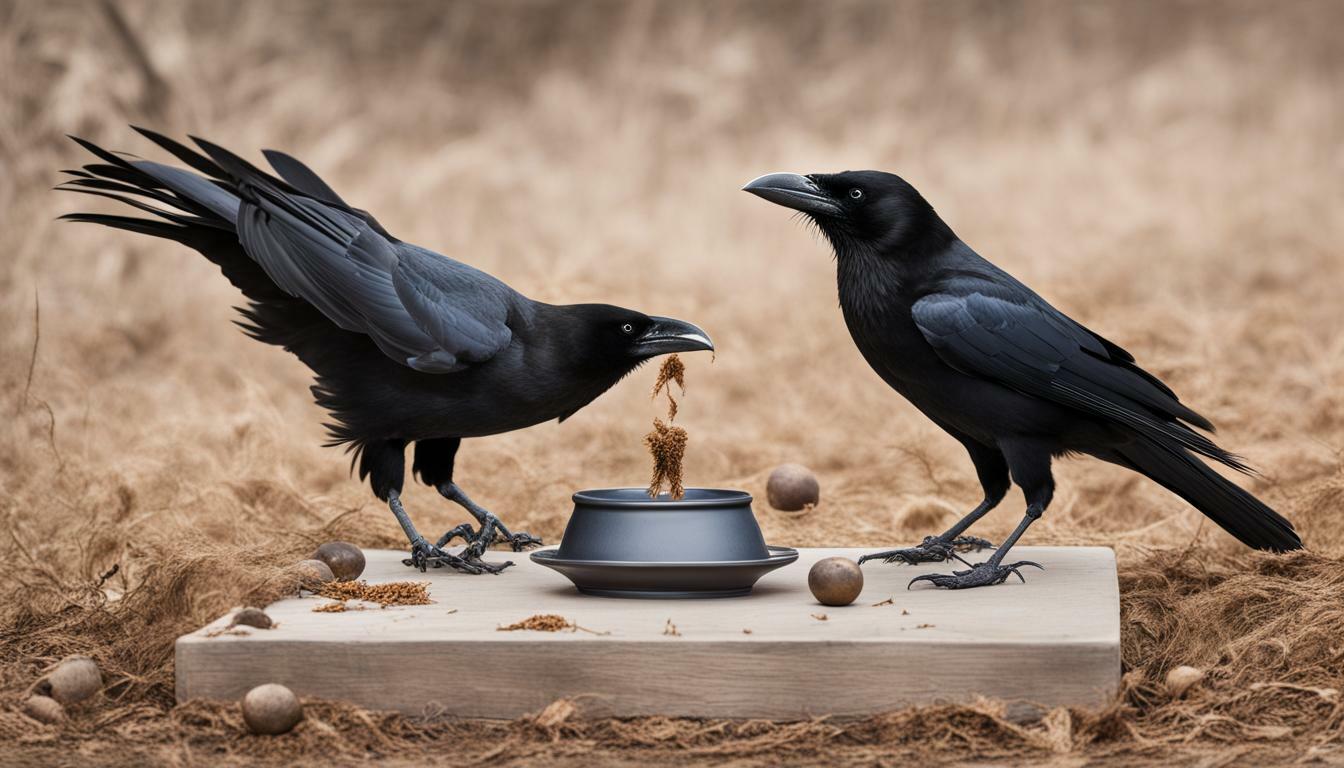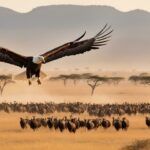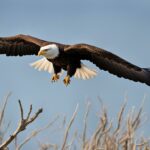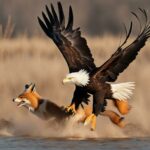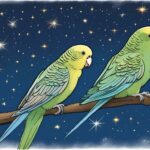When it comes to birds, crows are often misunderstood. While they have a reputation for being intelligent and adaptable, many people wonder about their dietary habits. Specifically, one common question is whether crows eat dead animals. In this article, we’ll examine the truth about crows and their diet, including their role as scavenger birds and the significance of their behavior for the ecosystem.
Key Takeaways:
- Crows are scavenger birds that consume dead animals as part of their natural diet.
- Their scavenging behavior contributes to the ecosystem by aiding in nutrient recycling and disease control.
- Contrary to popular belief, crows do not primarily hunt live prey and are not responsible for killing smaller birds.
Understanding Crow Behavior and Diet
Crows are highly intelligent birds that exhibit a range of behaviors. They are known to be problem solvers and have been observed using tools, recognizing human faces, and communicating with a complex language of calls and gestures. Their diet is diverse, consisting of a variety of natural food sources and human-made garbage.
Crows are considered avian scavengers, meaning they prefer to consume dead animals rather than actively hunt live prey. They play an important role in the ecosystem as carrion feeders, aiding in the natural decomposition process and nutrient recycling. However, they are also known to raid other birds’ nests and consume eggs and chicks, leading some to believe that they are responsible for killing smaller birds.
Crow Diet
Crows have a diverse diet that includes insects, fruit, nuts, seeds, small mammals, and carrion. They are known to scavenge from roadkill and other sources of dead animals, and will even consume human-made garbage such as fast food and discarded snacks.
Despite their preference for scavenging, crows have been observed actively hunting smaller birds, rodents, and reptiles. This behavior is more common in urban areas where natural food sources may be scarce.
Crow Behavior
Crows are social birds that form large groups, or murders, for roosting and foraging. They communicate with each other through a variety of calls and gestures, and have been observed engaging in complex social interactions such as grooming and playing.
Crows are also highly adaptable and opportunistic feeders, adjusting their diet based on available food sources. They will often follow other animals such as raccoons and coyotes to scavenge on the remains of their kills.
Overall, understanding crow behavior and diet is important to appreciate their role as avian scavengers and their contribution to the natural ecosystem. While they may occasionally consume live prey, their preference for scavenging and carrion feeding is a crucial aspect of their behavior.
The Role of Crows in Wildlife Scavenging
Crows play an essential role in the natural decomposition process, contributing to the ecosystem’s balance by consuming carrion left by dead animals. As carrion feeders, they prevent the build-up of decaying organic matter, which can harbor dangerous pathogens and bacteria that pose a threat to other animals and the environment.
By consuming dead animals, crows provide the critical service of recycling nutrients. When an animal dies, its body begins to break down, releasing nutrients that were stored in its tissues. Crows help the decomposition process by consuming the carrion, and the nutrients are then returned to the soil where they can be used by plants and other organisms.
Aside from aiding in nutrient recycling and decomposition processes, crows also help regulate the spread of diseases. By consuming carrion, crows help prevent the spread of diseases that may otherwise infect other animals that come into contact with the carcass.
The Importance of Wildlife Scavenging Behavior
Wildlife scavenging behavior is an essential mechanism in maintaining the health of ecosystems. Without scavengers like crows, dead animals would accumulate, and the decaying organic matter would release toxic chemicals and pathogens into the ecosystem, posing a threat to other animals, plants, and even humans.
Crows, along with other scavenger species, play an essential role in keeping the ecosystem healthy and balanced. As carrion feeders, they contribute to the natural decomposition process and aid in the recycling of nutrients, preventing the build-up of dangerous toxins and bacteria. By doing so, they help ensure the survival of both their own species and the ecosystem they inhabit.
Debunking Common Misconceptions
There are several misconceptions surrounding the diet of crows, including the belief that they primarily eat live animals. This is not accurate. In fact, crows are opportunistic scavengers with a varied diet that includes both natural sources of food, such as nuts and berries, and human-made garbage.
Another commonly held belief is that crows are responsible for killing smaller birds. This is also not true. While crows will attack other birds, it is typically limited to territorial disputes. They do not actively hunt live prey as a primary food source.
It is important to note that while crows do consume dead animals, their diet is not limited to corpses alone. They are adaptable creatures that will adjust their diet based on what is available to them. This includes scavenging from roadkill and other sources of dead animals.
Overall, the idea that crows are “corpse-eaters” is a misconception. While they do scavenge dead animals, it is not their primary food source, and they play an important role in the natural decomposition process, aiding in the recycling of nutrients and controlling the spread of disease.
Crows as Opportunistic Feeders
Crows are highly adaptable birds known for their opportunistic feeding behavior. They are incredibly intelligent and can quickly learn to scavenge from a variety of sources, including roadkill and other sources of dead animals.
While crows are often associated with human-made garbage as a food source, they are also known to feed on a range of natural food sources, including insects, fruits, and seeds. Their diet can vary depending on the availability of food.
These birds have a unique ability to find and access food, using problem-solving skills and even tools to obtain their prey. For example, crows have been observed dropping nuts onto roads, waiting for cars to crush them, and then returning to the road to retrieve the exposed nut meat.
Overall, crows’ adaptable feeding behavior and intelligence allow them to survive in a variety of habitats and contribute to the natural decomposition process by consuming dead animals.
Conclusion
In conclusion, crows are indeed scavenger birds that consume dead animals as part of their dietary habits. While they also eat other natural food sources and human-made garbage, their role as avian scavengers is significant in the natural decomposition process.
Crows aid in the recycling of nutrients and control the spread of disease by consuming carrion, contributing to ecosystem balance. Despite common misconceptions, crows do not primarily eat live animals or kill smaller birds.
As opportunistic feeders, crows adapt their diet based on available food sources, including roadkill and other sources of dead animals. Their intelligence in finding and accessing food is a testament to their survival skills.
Overall, understanding crow behavior and their role in wildlife scavenging is crucial to comprehending the complex ecosystem in which they reside. By debunking misconceptions and shedding light on their feeding habits, we can appreciate the important role these intelligent birds play in our environment.
Do Crows Eat Squirrels When They Are Dead?
Crows and squirrels: the truth revealed. Crows are opportunistic scavengers, known to feed on various types of animal carcasses. While they primarily eat dead animals, including roadkill, it is rare to see crows preying on healthy squirrels. However, if a squirrel were to die due to natural causes or become roadkill, crows may take advantage of the opportunity as an easy meal.
FAQ
Q: Do crows primarily eat dead animals?
A: Yes, crows are scavenger birds and do consume dead animals as part of their diet.
Q: Are crows responsible for killing smaller birds?
A: No, crows generally consume dead animals rather than actively hunting live prey.
Q: What else do crows eat besides dead animals?
A: Crows are opportunistic feeders and adapt their diet based on available food sources. They also scavenge from roadkill and consume human-made garbage.
Q: What is the role of crows in wildlife scavenging?
A: Crows play a significant role in the natural decomposition process by consuming carrion. They help recycle nutrients and control disease spread.
Q: Are crows intelligent in finding and accessing food?
A: Yes, crows are known for their intelligence and ability to find and access food, including dead animals.

